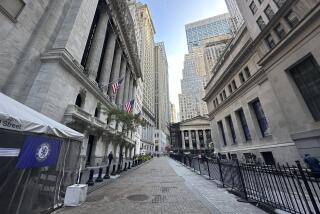Chief Defends Fed Acts Amid Stock Bubble
- Share via
WASHINGTON — Federal Reserve Chairman Alan Greenspan on Friday defended the central bank’s response to the late 1990s stock market bubble, saying the Fed had no way to dampen investor euphoria without endangering the entire economy.
In an unusual public defense of his actions, Greenspan rejected arguments that the Fed could have contained the bubble and the mess it left behind by tightening the supply of money and nudging interest rates higher before stock prices soared.
“The notion that a well-timed, incremental tightening could have been calibrated to prevent the late-1990s bubble is almost surely an illusion,” Greenspan said.
Slowing the stock market would have required “nothing short of a sharp increase in short-term rates” that would have risked a serious economic downturn, he told participants at a Fed conference in Jackson Hole, Wyo.
Greenspan was responding to one of the more pointed criticisms of his 15-year stewardship of the Fed. He is given generally high marks for keeping inflation at historically low levels, but some Fed watchers say the bank’s actions contributed to the speculative excesses of the late 1990s--and the pain inflicted on millions of investors when stock prices collapsed.
From March 2000, when the markets reached their high point, through this July, more than $7 trillion in stock market value evaporated. The 1990s bubble ultimately was deflated by a combination of forces, including the recognition that many high-tech start-ups had poor prospects of ever turning a profit.
The Fed might have pricked the bubble at an earlier point with more aggressive interest rate increases, Greenspan said, but doing so might have triggered a severe recession--”the very outcome we would be seeking to avoid.” The U.S. economy entered a recession last year, but economists said it was considerably milder than the downturn Greenspan feared he would trigger with a big interest rate increase during the late 1990s stock run-up.
After expressing concern about “irrational exuberance” in 1996, Greenspan became so enchanted with technology-driven productivity growth, some critics say, that he was slow to recognize just how exuberant investors had become.
“It was an unusually defensive speech by the chairman,” said Tom Schlesinger, executive director of the Financial Markets Center, a watchdog group based in Philomont, Va. “This is not the kind of speech that the chairman would have given when the economy and the Fed were both riding so high two years ago.”
Some economists interpreted Greenspan’s remarks not only as an attempt to justify the Fed’s actions during the recent boom-and-bust cycle but also as a preemptive move to deflect pressure to respond more aggressively to future financial market fluctuations.
“There has been a lot of commentary about the Fed targeting equity markets,” said John Sylvia, chief economist at Wachovia Securities in Charlotte, N.C. “I think Greenspan clearly wanted to say, ‘No, we can’t do that.’ ”
Greenspan acknowledged that Fed officials found themselves in unfamiliar territory in the late 1990s. The economy had been expanding for the better part of a decade, and bullish investors had bid up stock prices to unprecedented levels in relation to their underlying earnings.
“We were confronted with forces that none of us had personally experienced,” he said.
Aside from Japan’s continuing struggle with asset deflation, Sylvia said, “only history books and musty archives gave us clues to the appropriate stance for policy.”
He said Fed officials were concerned that stock prices appeared to be rising to unsustainable levels. Even so, he said, “we recognized that despite our suspicions, it was very difficult to definitively identify a bubble until after the fact ... when its bursting confirmed its existence.”
Greenspan noted that the Fed raised short-term interest rates by 1 1/2 percentage points from mid-1999 through May 2000, but during virtually all that period stock prices remained at record highs. It was not the first time markets had failed to follow the Fed’s lead: Stock prices rose after even bigger rate hikes in 1989 and 1994.
In his speech, Greenspan also rejected suggestions that the Fed could have reined in a runaway market by raising margin requirements, which limit the ability of investors to buy stock with borrowed funds. He said margin debt is mainly used by small investors who account for a narrow slice of market activity.
“The only effect of raised margin requirements is to price out the very small investor without addressing the broader issue of stock price bubble,” he said.
Sung Won Sohn, chief economist at Wells Fargo & Co. in Minneapolis, said it appeared in hindsight that the Fed stoked an already overheated stock market by cutting interest rates in 1998 and the first half of 1999.
But the central bank did so partly to keep the Asian financial crisis and other economic shocks from triggering a broader downturn--a sensible decision under the circumstances, Sohn said.
“At the time, the risk of not cutting interest rates was a credit freeze and a global recession,” Sohn said. “The risk of easing too much was probably a stock market bubble. I assume they made a conscious decision based on risk and reward.”
Stephen Moore, president of the Washington-based conservative Club for Growth, said the debate over Greenspan’s handling of the stock bubble raises the bigger question of whether the central bank should even consider intervening in financial markets.
“I think it would be healthy if the Fed chairman didn’t even talk about the stock market, quite frankly,” Moore said.
More to Read
Inside the business of entertainment
The Wide Shot brings you news, analysis and insights on everything from streaming wars to production — and what it all means for the future.
You may occasionally receive promotional content from the Los Angeles Times.










